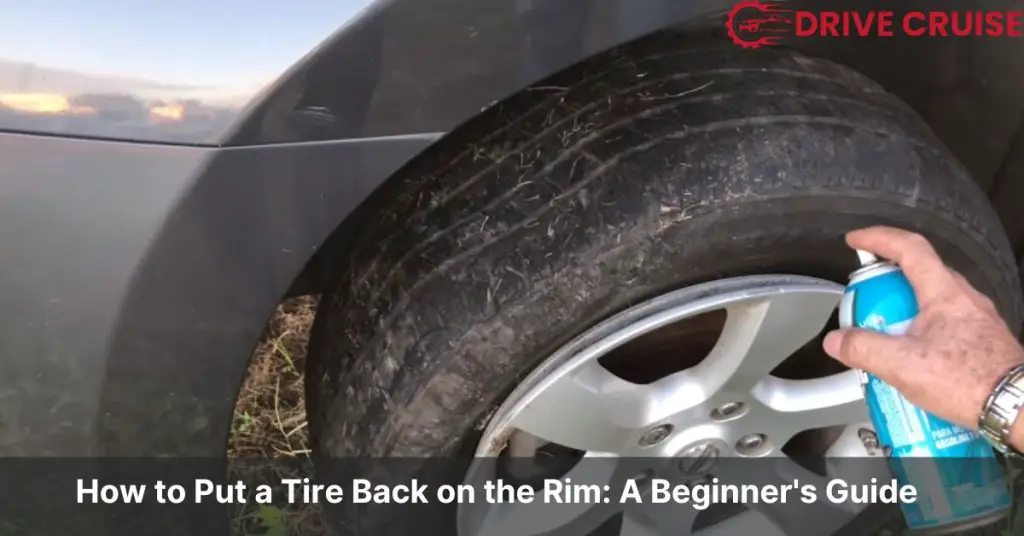If you’ve ever had to change a flat tire, you know that putting the tire back on the rim can be a bit tricky. To ensure a secure and safe seal, it’s important to follow proper techniques when mounting a tire on the rim. In this article, we’ll go over the steps for how to put a tire back on the rim, including how to do it without a machine.
First, make sure the tire and rim are the correct size. If they don’t match, you’ll need to get a different tire or rim so the sizes match. Once you’ve confirmed the size, lay the rim on the ground with the front side facing up. Then, lubricate the interior beads (inner edges) of the tire with dish soap. This will make it easier to slide the tire onto the rim.
Next, place the tire onto the rim, starting at the top. Use your hands to push the tire down onto the rim, working your way around the tire. If the tire is difficult to push down, you can use a tire lever to help. However, be careful not to damage the tire or rim. Once the tire is fully on the rim, inflate it to the recommended pressure. Congratulations, you’ve successfully put a tire back on the rim!
Preparation is Key: Tools and Materials
Before you start mounting your tire onto the rim, it’s important to gather all the necessary tools and materials. This will ensure that the process is safe and successful. In this section, we’ll discuss the essential tools you’ll need, as well as some work area considerations.
Essential Tools
Here are the essential tools you’ll need for mounting a tire:
- Tire irons (2 or 3 lever-style irons are recommended)
- Valve stem tool (for removing and installing the valve stem)
- Lubricant (soapy water solution or a dedicated tire mounting lubricant)
- Air compressor (with a pressure gauge)
- Safety glasses (to protect your eyes from debris)
- Optional: Tire bead seater (can be helpful for stubborn tires)
Using tire irons is the most common way to mount a tire onto a rim. You’ll need at least two tire irons to get the job done, but having three can make the process easier. A valve stem tool is necessary for removing and installing the valve stem, which is necessary for inflating the tire. Lubricant is important for helping the tire slide onto the rim without causing damage. An air compressor with a pressure gauge is necessary for inflating the tire to the correct pressure. Safety glasses are important for protecting your eyes from debris, especially when removing the old tire from the rim. A tire bead seater is optional, but can be helpful for stubborn tires that won’t seat properly.
Work Area Considerations
In addition to having the right tools, it’s important to have a clean, flat, and sturdy work surface with enough space to maneuver the tire and rim comfortably. Make sure the area is free of debris, and that there’s enough space to move around the tire and rim without bumping into anything. A sturdy work surface will ensure that the tire and rim don’t move around while you’re working on them, which can be dangerous.
The Mounting Process: A Breakdown
Putting a tire back on the rim can be a daunting task, but with the right tools and technique, you can do it yourself. Here’s a breakdown of the mounting process to help you get started.
Dislodge One Bead
To begin, use the tire irons to carefully pry one side of the tire bead (the low side) off the rim flange. Position the tire iron so that it is perpendicular to the rim and gently apply force to dislodge one side of the tire bead. Be sure to avoid damaging the rim or the tire bead during this process.
Lubricate the Bead and Rim
Applying a lubricant to both the tire bead and the rim flange can make the mounting process smoother and prevent pinching. Use a soapy water solution or a dedicated lubricant to coat the bead and rim. This will help the tire slide over the rim more easily and reduce the risk of damaging the tire or rim.
Work the Second Bead Over the Rim
Starting on the opposite side (high side) of the dislodged bead, use the tire irons to gradually work the remaining bead over the rim flange. Create slack by using a lever motion with the tire iron and maneuver the tire over the rim in sections. Be patient and work slowly to avoid damaging the tire or rim.
Reinstall the Valve Stem
If the valve stem was removed during the process, use the valve stem tool to properly reinstall it and ensure a tight seal. Make sure the valve stem is straight and tightened securely to prevent air leaks.
Inflate the Tire
Connect the air compressor to the valve stem and slowly inflate the tire to the recommended pressure as specified on the tire sidewall. Listen for any air leaks and visually inspect the bead for a complete and secure seal around the rim.
Final Touches and Safety Checks
Double-check the tire pressure and retighten the valve stem core if needed. Visually inspect the entire tire and rim for any bulges, damage, or leaks before reinstalling the tire on the vehicle. Safety should always be your top priority.
Beyond the Basics: Pro Tips and Troubleshooting
Techniques for Stubborn Tires
Some tires may be more challenging to mount than others. In such cases, you might need to use some advanced techniques to get the job done. One such technique is to use a tire bead seater tool. This tool can be helpful in forcing the final section of the bead over the rim flange safely.
Safety Precautions
When it comes to mounting tires, safety should always be your top priority. To avoid injuries, make sure you use proper tools and techniques. Keep your body positioned away from the rim while using the tire irons to prevent pinching or flying debris.
When to Seek Professional Help
If you encounter significant difficulty mounting the tire, suspect any rim damage, or lack the confidence or necessary tools to perform the task safely, it’s best to seek professional help from a tire shop. They have the expertise and equipment to handle such situations and can ensure that your tire is mounted correctly and safely.
Conclusion: A Secure Mount for Safe Travels
In this guide, you have learned the essential steps to safely mount a tire on the rim. To summarize, the key steps involved in the process include:
- Lubricating the tire beads and the lip of the rim
- Placing the tire over the rim at a 45-degree angle
- Using your hands to pull the tire over the rim
- Inflating the tire to the recommended pressure
It is important to note that using proper tools, techniques, and safety precautions is crucial when mounting a tire on the rim. This includes using tire lubricant, tire irons, and a tire pressure gauge, as well as wearing protective gloves and eyewear.
By following these steps and taking the necessary precautions, you can ensure a safe and secure ride. A properly mounted tire will provide better traction, handling, and stability on the road, reducing the risk of accidents and increasing your overall driving safety.
Related Posts:







